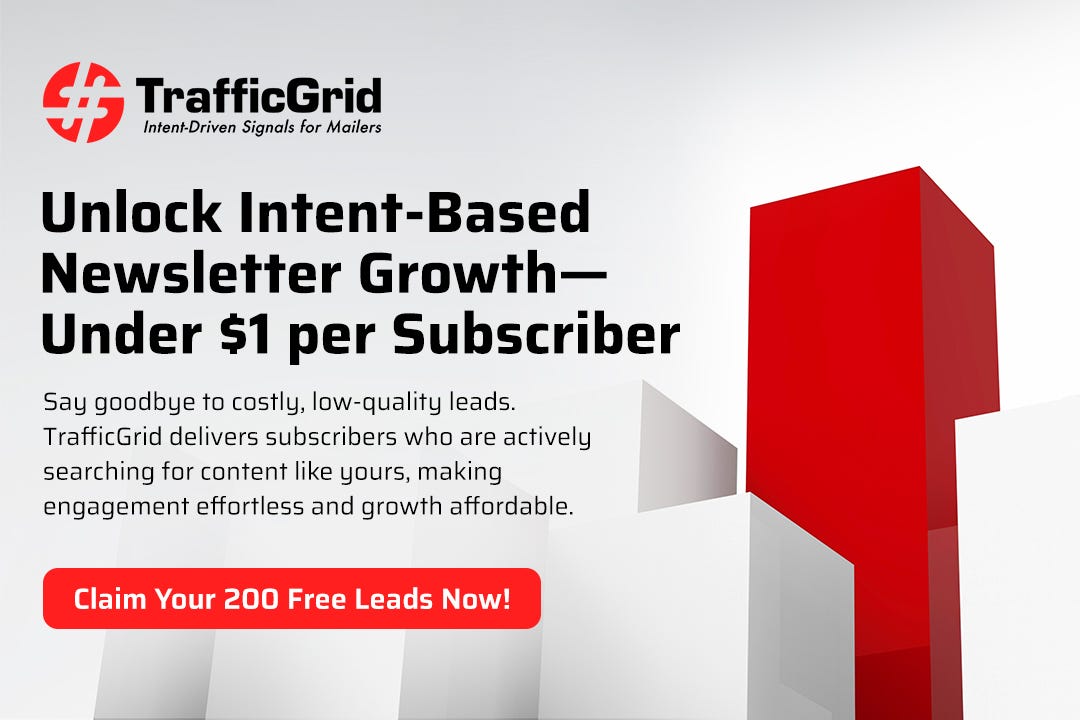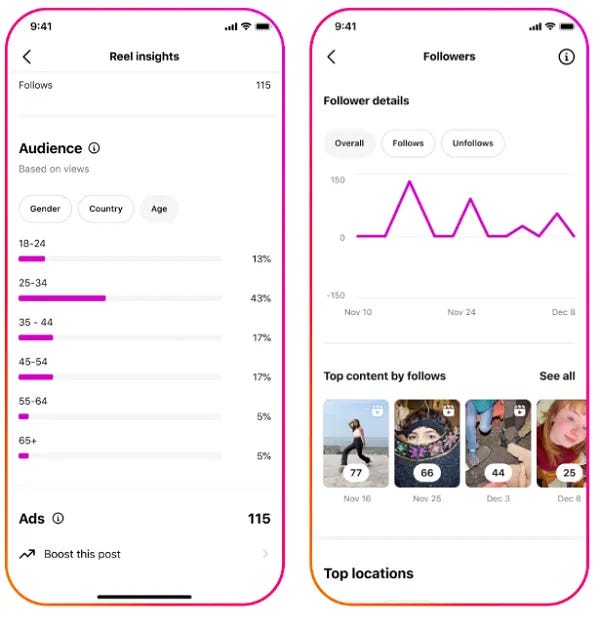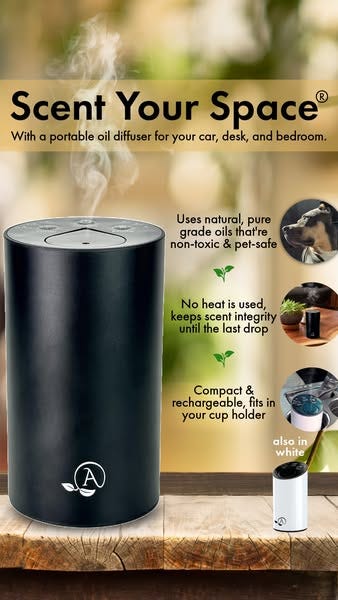Seasonal Spikes are Killing Your LTV
📈 The simple multiplier model smart brands use to protect loyalty and margins, Meta & Instagram Roll Out AI Engagement Gains and New Creator Metrics, and more!
Howdy Readers 🥰
In this newsletter, you’ll find:
📈 The CX Volume Multiplier Model: How Smart Brands Predict, Protect, and Profit From Seasonal Spikes
🗞️Meta & Instagram Roll Out AI Engagement Gains and New Creator Metrics
🏆 Ad of the Day
If you’re new to ScaleUP then a hearty welcome to you, you’ve reached the right place along with 50k+ CEOs, CMOS, and marketers. Let’s get into it, shall we? Oh! Before you forget, if someone forwarded this newsletter to you, don't forget to subscribe to our newsletter so you never miss out!
Together with TrafficGrid
Get 200 High-Intent Subscribers Before You Spend a Dollar
What if your free trial outperformed your best paid campaign?
TrafficGrid delivers 200 free U.S.-based subscribers for the test who actually open, click, and convert, before you ever pay. These aren’t giveaway leads.
They’re sourced using 30+ real-time intent signals that match your content to readers already engaging in your niche.
Most clients hit $1 cost-per-lead or less, with open rates above 50%.
One publisher in the sports category saw a 53.14% open rate and over 1,100 clicks in just 30 days.
But it all starts with the first 200, completely free!
If you’re publishing to 5,000+ U.S. subscribers and send weekly, you qualify for the test campaign.
From there, TrafficGrid will show you how to turn performance into scale, without wasting budget on unproven lists.
Want to see if 200 leads can outperform your list?
📈 The CX Volume Multiplier Model: How Smart Brands Predict, Protect, and Profit From Seasonal Spikes
Most brands think seasonal spikes are about staffing up. Smart operators know they’re about protecting LTV while extracting more profit from peak traffic.
The difference? One runs on overtime budgets; the other operates on predictive modeling that controls customer perception during times of chaos.
The CX Volume Multiplier Model
At the core is a simple equation:
Ticket Load Forecast = Historical Baseline × Campaign Multiplier × CX Latency Factor
Historical Baseline – Average daily tickets per order from at least 2 years of data (exclude anomalies like outages).
Campaign Multiplier – Historical ticket lift by promo type. Example: sitewide BFCM sale = ×2.8, limited-edition drop = ×1.9.
CX Latency Factor – How much ticket volume increases for every 12-hour delay in first response. In fashion, latency can add 15–25% ticket load from duplicate queries.
Pro teams often layer automation early in the process to neutralize the latency factor. A tool like Tidio Copilot can pre-fill, template, or AI-generate answers for repetitive queries, cutting duplicate ticket volume before it compounds. You can download the free Chrome extension here and check it out.
Benchmarks That Separate Amateurs From Pros
In steady-state conditions, Smart DTC operators track ratios like one ticket per 15–20 orders for apparel, one per 25 orders for beauty, and one per 10 orders for high-AOV products, knowing that seasonal spikes often push this to one ticket per nine orders or worse if unprepared.
They also hold to strict LTV preservation thresholds, maintaining sub-12-hour first response and sub-36-hour resolution during peaks, because letting these slip can cause a 15–30% drop in repeat purchase probability.
Anything slower turns customer reactivation into an unnecessary ad expense, as you end up paying to win back people who are still waiting for help.
The Contrarian Edge: Spikes as Revenue Triggers
While most brands see seasonal spikes as something to survive, the best operators deliberately use them as revenue catalysts. They turn support interactions into moments of predictable scarcity by upselling limited restock notifications, slipping in win-back offers tied to the context of the spike
(“Because you braved the wait…”), and use the surge in conversations as a real-time product feedback engine that informs Q1 merchandising decisions.
In this view, forecasting isn’t just about adding capacity; it’s about engineering campaigns that convert peak chaos into peak profitability.
System Map: Forecasting → Buffering → Automation
Forecast – Run the Volume Multiplier Model 90 days out.
Buffer – Add overflow agents only for high-value segments; prep self-serve answers for low-value queries.
Automate – Deploy AI-assisted triage (like Tidio Copilot) mid-spike to absorb repetitive load instantly so human agents can focus on LTV-critical tickets.
This transforms seasonal peaks from a drain into a loyalty machine — and it’s repeatable every year.
🗞️Meta & Instagram Roll Out AI Engagement Gains and New Creator Metrics
Meta is deepening AI integration across its apps, driving higher engagement, prioritizing original content, and refining ad targeting. Meanwhile, Instagram is rolling out new analytics tools to help creators pinpoint what’s resonating.
The Breakdown:
1. AI-driven engagement surge – Instagram video time jumped over 20% YoY globally, with Facebook seeing the same in the U.S. AI recommendations have lifted overall time spent by 5% on Facebook and 6% on Instagram this year, while Reels now account for half of all IG watch time.
2. Push for original content – Two-thirds of recommended content in the U.S. now comes from original posts. Meta’s algorithms are prioritizing freshness to surface new creator content quickly, aiming to keep their audiences on the platform.
3. New precision engagement insights – Instagram adds “When people liked your reel” and “When people liked your carousel” charts, plus post-level demographic and follower growth data. Creators can now pinpoint exactly which moments or slides drove likes to guide future posts.
4. Metrics shift to views –Instagram is replacing “Accounts Reached” with “Views” to track actual watchers. All content types will use this metric, aligning analytics with true engagement.
Why it matters – Meta is pairing AI-powered engagement lifts with creator-facing data that reveals exactly what’s working. For brands and creators, this means more precise targeting and better-informed content decisions.
🏆 Ad of the Day
What Works:
1. Headline Delivers Lifestyle Promise, Not Just Product Utility - “Scent Your Space®” isn’t just a function, it’s a feeling. It invites the viewer to imagine personalizing their environment with ease and elegance. The tagline “for your car, desk, and bedroom” smartly expands use cases across daily life, increasing perceived value through versatility.
2. Pet-Safe & No-Heat Claims Anchor It in Trust and Science - The phrases “non-toxic & pet-safe” and “no heat is used” address two major buyer concerns: safety and scent integrity. These aren’t just features, they’re reassurances, especially powerful for buyers with pets or allergies.
3. Design Speaks to Aesthetic Minimalism + Everyday Convenience - The black cylindrical shape, clean font, and mention of “fits in your cup holder” appeal to buyers who love sleek, practical design. By showing both black and white colorways, the ad reinforces that this product fits into any aesthetic, from a minimalist office to a cozy home.
Broader Insights:
This ad nails a rising trend: wellness products are no longer confined to spas and rituals. They’re becoming everyday essentials. “Scent Your Space” isn’t framed as indulgent, but as integrated, part of your commute, workflow, or downtime.
Advertise with Us
Wanna put out your message in front of over 50,000 best marketers and decision makers?
We are concerned about everything DTC and its winning strategies. If you liked what you read, why not join the 50k+ marketers from 13k+ DTC brands who have already subscribed? Just follow this.
At ScaleUP, we care about our readers and want to provide the best possible experience. That's why we always look for ways to improve our content and connect with our audience. If you'd like to stay in touch, be sure to follow us EVERYWHERE🥰
Thanks for your support :) We'll be back again with more such content 🥳




